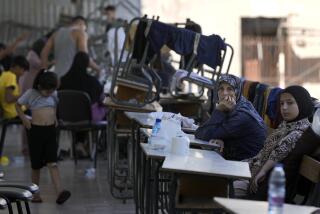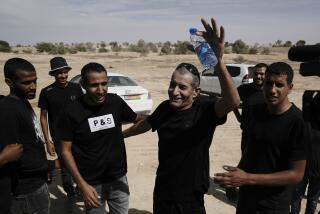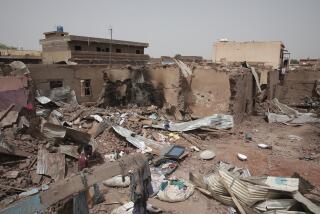Once-Besieged Sudanese City Makes Comeback
JUBA, Sudan — Thousands here fled the horrors of Sudan’s civil war. Some even sought refuge in graveyards, growing food in the cemeteries of Juba, where the more unfortunate were buried.
The once-prosperous city was a symbol of an unending conflict: cargo planes bringing in scant relief, shells crashing down from rebel artillery, hundreds of thousands of refugees streaming into a city redolent of death.
Today, Juba is no longer a symbol of the war. It’s an oasis.
The nearly 13-year-old war--and the death and hunger it brings--still ravages southern Sudan, keeping wretched refugee camps filled outside Khartoum, the capital in the north.
But in Juba, what might be called peace has come to a city that was once in the middle of the government’s fight with the rebels. Children are clothed, food is plentiful and crops of cassava, sorghum and peanuts ripen in Juba’s fertile fields.
“Citizens are now feeling assured,” said Adam Tahir Hamdoon, the deputy governor of the region around Juba.
Hamdoon was appointed by the Khartoum government, which is dominated by the Arabs of northern Sudan.
For years, it was not safe to venture unarmed farther than five or six miles from the city. “Now you can move about with nothing but your walking stick to about 125 kilometers [78 miles] outside Juba,” Hamdoon said.
Situated on the White Nile about 750 miles south of Khartoum, Juba was besieged by rebels of the Sudan People’s Liberation Army beginning in the mid-1980s.
The southern rebels, mainly black Christians and followers of tribal religions, began fighting in 1983 for autonomy from Khartoum, which they felt was trying to forcibly impose the Islamic religion and the Arabic language. They also sought a more equitable distribution of wealth they believed was monopolized by the north.
Juba was one of the war’s prizes, commanding a vast region and serving as a key transportation hub along the Nile.
As part of the battle, rebels relentlessly shelled the city from nearby hills, killing dozens of civilians.
Amnesty International, meanwhile, accused government troops in 1992 of killing at least 200 civilians in Juba during house-to-house searches for rebel sympathizers.
Some civilians were reportedly were taken out onto the streets and shot point-blank after interrogation by soldiers.
At that time, 70% of the city’s 400,000 residents were refugees, dependent on airlifts of food. They lived in the open in the city’s main gardens or in mud-walled houses covered in green canvas left long ago by relief agencies.
The government allocated cemetery plots for farming and provided seeds for staples such as corn to help refugees get by.
Many in Juba survived, while more than 1.5 million Sudanese in the countryside have perished in the war, which has largely been overshadowed by other African cataclysms in Rwanda, Ethiopia and Somalia.
The war has moved away from Juba following government victories and splits in the rebel movement that have weakened its ability to resist government offensives.
Rebel groups battle each other as well as government troops and some militias have turned to marauding.
The strife has hindered efforts to deliver food supplies, U.N. officials say, although this year’s crops may be good. Diseases run rampant.
In Juba, life is brighter.
The government in Khartoum has made an effort over the past three years to appoint southerners, usually Christians, to leadership positions in cities and towns it controls in the south.
Of the six officials in charge of the region around Juba, four are Christians and two are Muslims.
All but one come from the region itself.
“There’s definitely an effort made to charm a victory than to win it militarily,” said Phillip O’Brien, head of the U.N. group that coordinates relief in southern Sudan.
The government also has not tried to impose an Islamic-based legal system, which is fiercely opposed by southerners.
With no fighting in the area, people are now leaving Juba to return to the neighboring towns of Rokon, Mongalla and Yie.
The countryside is already planted with corn, sweet potatoes, cassava, peas and peanuts, often with farming implements provided by the United Nations and relief groups.
Inside Juba, the green canvas is gone, replaced by thatched roofs. Most of the planes landing at the city are carrying not relief supplies but goods purchased by merchants from Khartoum.
Electricity and running water are available 20 hours a day, and schools are functioning for the first time in years.
Lush trees that once bore mangoes, papayas and bananas were cut down to deprive rebels of cover during the earlier fighting.
However, locally produced food is plentiful and the swollen bellies of children have all but disappeared.
Juba’s two markets are packed with women buying and selling.
Agnes Lukudo, the Christian governor, said she was told by relief officials last year that no more aid was needed in Juba.
The people struggling today are government employees, who have not received their salaries for months, she said.
“We are moving to rehabilitation and development,” she said.
More to Read
Sign up for Essential California
The most important California stories and recommendations in your inbox every morning.
You may occasionally receive promotional content from the Los Angeles Times.










